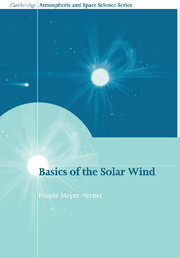Book contents
- Frontmatter
- Contents
- Preface
- 1 The wind from the Sun: an introduction
- 2 Tool kit for space plasma physics
- 3 Anatomy of the Sun
- 4 The outer solar atmosphere
- 5 How does the solar wind blow?
- 6 Structure and perturbations
- 7 Bodies in the wind: dust, asteroids, planets and comets
- 8 The solar wind in the Universe
- Appendix
- Index
4 - The outer solar atmosphere
Published online by Cambridge University Press: 22 October 2009
- Frontmatter
- Contents
- Preface
- 1 The wind from the Sun: an introduction
- 2 Tool kit for space plasma physics
- 3 Anatomy of the Sun
- 4 The outer solar atmosphere
- 5 How does the solar wind blow?
- 6 Structure and perturbations
- 7 Bodies in the wind: dust, asteroids, planets and comets
- 8 The solar wind in the Universe
- Appendix
- Index
Summary
To study the corona and chromosphere requires a firm optimism.
H. C. Van de Hulst, 1950danger!! enter at your own risk!!
J. Newmark, 2003Not only does the Sun try to hide its interior, but it seems to take perverse pleasure in disguising its atmosphere. Van de Hulst's remark, which refers to solar eclipses (that invariably occurred by cloudy weather or after observers have contracted nasty diseases) remains true half a century later, albeit for quite different reasons. And the latter citation reminds us that observation of the outer solar atmosphere is still a difficult art; in opening new windows, progress in techniques has revealed a hierarchy of intricate patterns, reminiscent of a rainforest in which there is a profusion of insects, birds, flowers and trees that we can see but not touch, and whose understanding requires much subtlety.
We took a quick tour of the solar atmosphere in Section 1.2, and we shall now enter into more detail. We will have to complement our plasma physics tool box with some additives, in order to find intellectual coherence in the baroque architecture revealed by observation. By necessity, however, I shall draw an outrageously simplified picture, keeping only a few basic aspects. Far more complete accounts are given for example in [22], [48], [4] and references therein; a lucid survey can be found in [33] for solar activity – of which a nice historical point of view is given in [1].
Information
- Type
- Chapter
- Information
- Basics of the Solar Wind , pp. 165 - 222Publisher: Cambridge University PressPrint publication year: 2007
